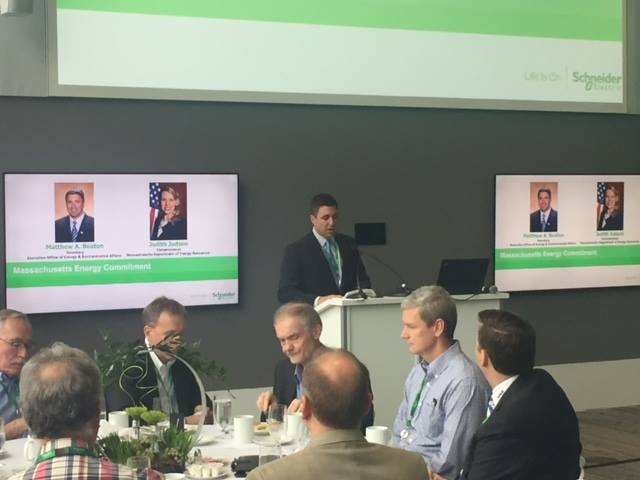
Matthew Beaton, Secretary, Executive Office of Energy and Environmental Affairs for Massachusetts, introduces Schneider’s U.S. headquarters new microgrid.
In the United States, where minimalism and simplicity aren’t always a system’s determining factors, microgrid technology has made possible many groundbreaking projects that could lead to new models for off-grid power generation, distribution, and storage. Following are two recent examples of important and innovative American microgrids, one a corporate project in Massachusetts and the other designed for affordable housing in New York City.
Schneider Corporate HQ to serve as “living lab” for microgrid innovation
A week ago, Schneider Electric unveiled an advanced microgrid at the company’s North American headquarters, the Boston One Campus (BOC), in Andover, Massachusetts. BOC serves as Schneider Electric’s North American headquarters and is one of five of the company’s global research and development centers worldwide. Made up of two buildings measuring more than 240,000 square feet, the campus is home to about 750 employees across all of Schneider Electric’s business units. The microgrid was built by Schneider Electric and REC Solar, a subsidiary of Duke Energy Renewables (Duke Energy is the project’s investor/owner). The microgrid was funded through the Microgrid as a Service (MaaS) business model for added resiliency and sustainability (with no upfront costs).
“Schneider Electric used this model at BOC to build an advanced microgrid that reduces costs, incorporates more sustainable energy and takes control of its energy future,” explains Mark Feasel, vice president, utility segment, smart grid & microgrid, Schneider Electric. “It will also be a living laboratory at our North American R&D hub, driving global innovation in energy storage and distributed energy resource management solutions.” The microgrid will be used to research and develop new microgrid technologies, solutions, and applications in a “real-world” environment.
The Schneider microgrid includes 1,379 solar modules as well as photovoltaic inverters that convert 448 kilowatts (kW) of direct current from solar to alternating current. Additionally, the microgrid uses a natural gas generator as an anchor resource, enabling the solar array to operate during grid outages, thus maintaining critical operations and giving employees a safe, shelter-in-place option. The system is designed to generate more than 520,000 kilowatt-hours (kWh) of electricity per year.
“As we continue to build a clean, affordable and resilient energy future for the Commonwealth, innovative companies like Schneider Electric are key to our shared success,” says Energy and Environmental Affairs Secretary Matthew Beaton. “The Baker-Polito Administration [Massachusetts Governor Charlie Baker and Lieutenant Governor Karyn Polito] is committed to supporting the emerging technologies being produced by Massachusetts’ world-class businesses, talented workforce and universities.”
In NYC, affordable housing microgrid boasts behind-the-meter lithium-ion batteries, energy plus storage
In September 2016, New York established an energy storage goal of 100 MWh by 2020, along with an expanded solar target of 1,000 MW by 2030. Storage is expected to play a key role in meeting the city’s plans to cut greenhouse gasses by 80% by 2050. Moving toward this goal is the renewable-energy-plus-storage microgrid at Marcus Garvey Village, a mixed-income apartment complex in New York City. The Marcus Garvey project features the first lithium-ion batteries approved for use in a behind-the-meter multi-family building application and the first renewable-energy-plus-storage microgrid in an affordable housing development
“We’re proud to be designing and building the city’s first lithium-ion battery based microgrid,” says Gregg Patterson, President and CEO of Demand Energy. “We look forward to bringing the benefits of this first-of-its-kind microgrid to the Village’s owners and residents.” Earlier this week, the company (acquired in January by Enel Green Power) announced the commencement of construction work on the project.
The Marcus Garvey microgrid consists of a 400 kW solar PV system and 400 kW fuel cell, supported by 300 kW / 1.2 MWh lithium-ion batteries. The system is designed to reduce the property’s power consumption, provide resilience during an outage, offer a lower operational cost, deliver essential load relief for Con Edison, and help reduce greenhouse gas emissions.
Will we see you this September in Denver for the 5th annual 2017 HOMER International Microgrid Conference?
More information coming soon!

